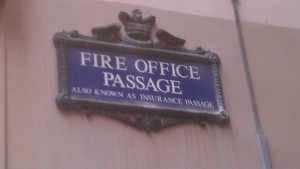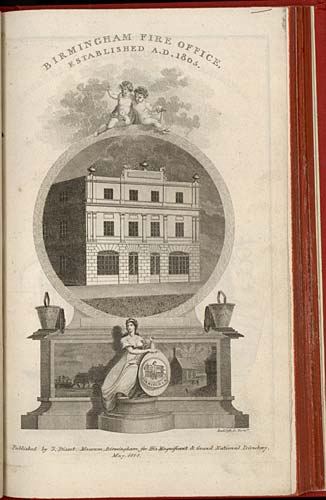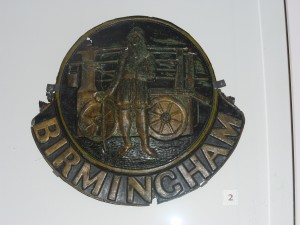Birmingham Fire Office: The Early Beginnings of Birmingham’s Fire service
In searching for inspiration for my next blog, I decided to turn to my own Birmingham ancestry for inspiration. My fourth Great Grandfather, Enos Edwards was the Chief Engineer for the Birmingham Fire Office working from 1807 until his death in 1862. His son Enos and other members of the family were also firemen and engineers for the company.
The Birmingham Fire Office was first established in March 1805, and in 1808 the company built its stone fronted office in Union Street at the expense of nearly £4000, which also included the engine house, fire-men’s houses, and stables. The picture below is from Bisset’s directory and shows the regency fire office building in 1808 (1)
My ancestor lived in the fire-men’s quarters which were in Union passage.
By 1839 the Birmingham Fire Office had two engines, one being decorated with wooden battle axes, and iron scroll-work painted in many colours and the other being very plain and drab. William Baddelsky writing in the illustrated weekly journal for iron and steel in 1835, described “if a fire breaks out on premises of the Society of Friends, of which there are a large number in Birmingham, the Drab engine is dispatched to their assistance; but if the goods or chattels of Jews or Gentiles are in jeopardy, the painted engine is brought out.” (2)
During the early days of fire fighting in Birmingham there was no organised municipal fire service like we have today, so people had to buy insurance from the many different insurance companies available of which the Birmingham Fire Office was an early example. These different insurance companies were represented by agents and Showell’s Dictionary of Birmingham describes their presence in the city “insurance agents offices are so thick on the ground round Bennet’s Hill and Colmore Row, that it has been seriously suggested the latter thoroughfare should he rechristened and be called Insurance Street. It was an agent who had the assurance to propose the change!” (3) To this day this area has remained Birmingham’s financial district.
According to William Hutton in his 1835 book The History of Birmingham, the rates of fire insurance varied for properties but ranged from 2 shillings and 6 pence to £100 per annum (3). Once insured with a company a fire mark had to be attached to building as proof of insurance. I actually found a Victorian example of the Birmingham Fire Office mark by chance on a visit to the BMAG’s History Galleries Exhibition, here it is below:
In the early history of fire fighting it was sometimes the case that when a fire broke out several insurance fire brigades would attend the fire, but if the building was not insured or had a rival fire-mark the brigade would return to base, or even try to sabotage the rival brigade. This often led to persons insuring their property with more than one company to ensure the fire would be put out.
On investigating the sites in present day Birmingham most of the Georgian and Regency buildings have long since disappeared and the only evidence of the old fire office, and any insurance and agent’s buildings now lies just off New Street, where the following sign can be seen.

This passage would have linked up to Colmore Row and Bennet’s Hill the areas described in Showell’s dictionary, so perhaps the aforementioned agent did sort of get his way after all on the renaming of street sign.
My ancestor Enos Edwards attended many Birmingham fires throughout his career and devoted his life to fire fighting in Birmingham. In his obituary in 1862 he was called the “Braidwood of Birmingham” so called after James Braidwood the founder of the world’s first Municipal fire service (in Edinburgh) and first director of the London Fire Engine Establishment. It is nice to know one of my ancestors played an important role in Birmingham’s history.
Sources:
(1) Image from: A Catalogue of Commerce and Art: Bisset’s Magnificent Guide for Birmingham, 1808 [From Birmingham Central Library]
(2) Illustrated weekly journal for iron and steel 1835
(3) Hutton, W. (1835). A history of Birmingham, edt by Guest, J. Birmingham. 6th Edition.
(4) Harman, T. and Showell, W. (2004)Showell’s Dictionary of Birmingham. A History And Guide Arranged Alphabetically





Your article was very interesting! I read it as I am doing family genealogy research. I am descended from Mary Ann Edwards, sister of Enos, Jr. I have a small pitcher that she brought to America with her and several letters that were written to her from England.
Hi
I am head of Fire Prevention and Protection training at the national Fire Service College in Moreton in Marsh. I am Brummie by birth although now live in the Cotswolds. The college has a heritage centre and displays various historic fire service related items, including pre Victorian fire appliances. If you have copies of anything that you feel would be useful to display then I am sure the college would be interested as it is very proud of its heritage. Not sure if anyone will see this but although I don’t run the heritage centre, you can contact me if you wish and I will pass it on to the right person so that any discussion can be had. sskarratt@fireservicecollege.ac.uk
Really enjoyed this article. Knew something about the Birmingham Fire Office but not in such detail. I am a direct descendant of Enos Sr. through his son, John (1835-1877) who did not follow tradition, being neither an engineer nor a fireman.
Very interesting article Julie. I came across it during research of my own family tree which also features Enos and his son Enos.
I have been researching the incident in 1858 involving Enos junior but have not been able to find out the final outcome . I wonder if you have any information on this ?
Hi John, thanks for message, I have lots of information on Enos Senior and Junior that may be useful for you, I have sent you a private message with the details.
Enos Edwards Jr. was charged with manslaughter in 1858, on the grounds that he interfered with an attempt to rescue a girl from a burning building. The details were not clear and the witnesses contradicted one another. The case was heard in 1859 and Enos was acquitted.
Hi Jennifer, thanks for your comment, it was an interesting case, I have read through the court docs and newspapers on this already. After he was released Enos left for America, where he then later died, so perhaps despite being acquitted there was still a stigma attached.
Just received the original work record of Thomas Edwards, the brother of Enos Edwards junior ,from when he joined the newly formed Birmingham Municipal in 1874 to when he retired in 1885.He was the original engineer . This gives the perfect transition of the Edwards family from the fire insurance companies to the modern embryonic fire service. Enos (senior) was my ggg grandfather and my son is at present a serving fireman in Lincolnshire and so is his daughters husband.
Really interesting Julie – It’s fascinating to see remnants of the past (street sign) in the landscape.
what a great building this is